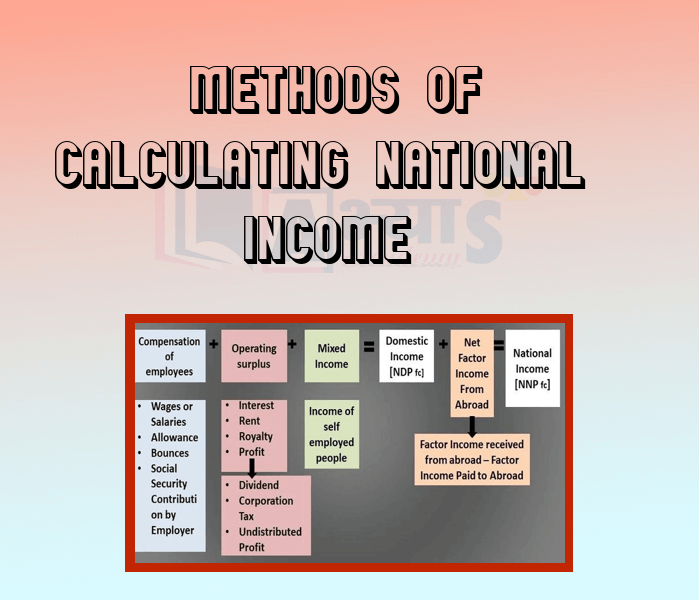Methods Of Calculating National Income

Methods For Calculating National Income
Methods of Measuring National Income:
There are four methods of measuring national income. Which method is to be used depends on the availability of data in a country and the purpose in hand.
1. Production Method
This method is based on the total production of a country during a year. According to this method, the total value of final goods and services produced in a country during a year is calculated at market prices. Only the final goods and services are included and the intermediary goods and services are left out. First of all production units are classified into primary, secondary and tertiary sectors then we identify the various units that come under these sectors. We estimate the goods and services produced in each of these sectors. The sum total of products produced in these three sectors is the total output of the nation. The next step is to find out the value of these products in terms of money. The money sent by Indian citizens working abroad is also added to this. Now we get the gross national income.
GDP = Money value of final goods and services + Income from abroad
2. Income Method
According to this method, the net income payments received by all citizens of a country in a particular year are added up, i.e. net incomes that accrue to all factors of production by way of net rents, net wages, net interest and net profits are all added together but incomes received in the form of transfer payments are not included in it.
GDP = Rent + Wage + Interest + Profit + Income from abroad
3. Expenditure Method
According to this method, the total expenditure incurred by the society in a particular year is a together and includes personal consumption expenditure, net domestic investment, government expenditure on goods and services, and net foreign investment. This concept is based on the assumption that national income equals national expenditure.
4. Value Added Method:
Another method of measuring national income is the value added by industries. The difference between the value of material outputs and inputs at each stage of production is the value added.
GDP = Individual Expenditure + Government Expenditure
Production method = Income method = Expenditure method
We have already noted that a part of the capital gets consumed during the year due to wear and tear. This wear and tear is called depreciation. Naturally, depreciation does not become part of anybody's income. If we deduct depreciation from GNP the measure of aggregate income that we obtain is called Net National Product (NNP). Thus,
NNP = GNP - Depreciation
It is to be noted that all these variables are evaluated at market prices. Through the expression given above, we get the value of NNP evaluated at market prices. But market price includes indirect taxes. When indirect taxes are imposed on goods and services, their prices go up. Indirect taxes accrue to the movement. We have to deduct them from NNP evaluated at market prices in order to calculate that part of NNP which actually accrues to the factors of production. Similarly, there may be subsidies granted by the government on the prices of some commodities (in India petrol is heavily taxed by the government, whereas cooking gas is subsidized). So we need to add subsidies to the NNP evaluated at market prices.
The measure that we obtain by doing so is called Net National Product at factor cost or National Income.
Thus, NNP at factor cost
= National Income (NI)
= NNP at market prices - (Indirect taxes - Subsidies)
= NNP at market prices - Net indirect taxes
where Net indirect taxes = Indirect taxes - Subsidies
Personal Income (P) = NI - Undistributed profits - Net interest payments made by households - Corporate tax + Transfer payments to the households from the government and firms.
However, even PI is not the income over which the households have complete say. They have to pay taxes from PI. If we deduct the Personal Tax Payments (for income tax), and Non - tax Payments (such as fines) from Pl, we obtain what is known as the Personal Disposable Income. Thus
Personal Disposable Income (PDI) = PI - Personal tax payments - Non-tax payments.
Personal Disposable Income is the part of the aggregate income which belongs to the households. They may decided to consume a part of it, and save the rest.
Real National Income is called _________________ | |||
| Right Option : A | |||
| View Explanation | |||
Students / Parents Reviews [20]
Abhyas institute is one of the best coaching institute in the vicinity of Ambala Cantt area. The teachers of the institute are well experienced and very helpful in solving the problems of the students.The good thing of the institute is that it is providing extra classes for the students who are w...

Aman Kumar Shrivastava
10thUsually we see institutes offering objective based learning which usually causes a lag behind in subjective examinations which is the pattern followed by schools. I think it is really a work of planning to make us students grab the advantages of modes of examination, Objective Subjective and Onli...

Anika Saxena
8thAbhyas is good institution and a innovative institute also. It is a good platform of beginners.Due to Abhyas,he has got knoweledge about reasoning and confidence.My son has improved his vocabulary because of Abhyas.Teacher have very friendly atmosphere also.

Manish Kumar
10thIt was good as the experience because as we had come here we had been improved in a such envirnment created here.Extra is taught which is beneficial for future.

Eshan Arora
8thIn terms of methodology I want to say that institute provides expert guidence and results oriented monitering supplements by requsite study material along with regular tests which help the students to improve their education skills.The techniques of providing education helps the students to asses...

Aman Kumar Shrivastava
10thMy experience with Abhyas is very good. I have learnt many things here like vedic maths and reasoning also. Teachers here first take our doubts and then there are assignments to verify our weak points.

Shivam Rana
7thWe started with lot of hope that Abhyas will help in better understnding of complex topics of highers classes. we are not disappointed with the progress our child has made after attending Abhyas. Though need to mention that we expected a lot more. On a scale of 1-10, we would give may be 7.

Manya
8thMy experience was very good with Abhyas academy. I am studying here from 6th class and I am satisfied by its results in my life. I improved a lot here ahead of school syllabus.

Ayan Ghosh
8thAbout Abhyas metholodology the teachers are very nice and hardworking toward students.The Centre Head Mrs Anu Sethi is also a brilliant teacher.Abhyas has taught me how to overcome problems and has always taken my doubts and suppoeted me.

Shreya Shrivastava
8thMy experience with Abhyas academy is very good. I did not think that my every subject coming here will be so strong. The main thing is that the online tests had made me learn here more things.

Hiya Gupta
8thThe experience was nice. I studied here for three years and saw a tremendous change in myself. I started liking subjects like English and SST which earlier I ran from. Extra knowledge gave me confidence to overcome competitive exams. One of the best institutes for secondary education.

Aman Kumar Shrivastava
10thThird consective year,my ward is in Abhyas with nice experience of admin and transport support.Educational standard of the institute recumbent at satisfactory level. One thing would live to bring in notice that last year study books was distributed after half of the session was over,though study ...

Ayan Ghosh
8thMy experience with Abhyas Academy has been very good. When I was not in Abhyas whenever teacher ask questions I could not speak it confidently but when I came in Abhyas, my speaking skills developed and now I am the first one to give the answer of teachers question.

Upmanyu Sharma
7thWhen I have not joined Abhyas Academy, my skills of solving maths problems were not clear. But, after joining it, my skills have been developed and my concepts of science and SST are very well. I also came to know about other subjects such as vedic maths and reasoning.

Sharandeep Singh
7thI have spent a wonderful time in Abhyas academy. It has made my reasoning more apt, English more stronger and Maths an interesting subject for me. It has given me a habbit of self studying

Yatharthi Sharma
10thAbhyas is an institute of high repute. Yogansh has taken admission last year. It creates abilities in child to prepare for competitive exams. Students are motivated by living prizes on basis of performance in Abhyas exams. He is satisfied with institute.

Yogansh Nyasi
7thIt was a good experience with Abhyas Academy. I even faced problems in starting but slowly and steadily overcomed. Especially reasoning classes helped me a lot.

Cheshta
10thAbhyas institute is one of the best coaching institute in the vicinity of Ambala cantt.The institute provides good and quality education to the students.The teachers are well experienced and are very helpful in solving the problems. The major advantages of the institute is extra classes for weak...

Shreya Shrivastava
8thBeing a parent, I saw my daughter improvement in her studies by seeing a good result in all day to day compititive exam TMO, NSO, IEO etc and as well as studies. I have got a fruitful result from my daughter.

Prisha Gupta
8thOne of the best institutes to develope a child interest in studies.Provides SST and English knowledge also unlike other institutes. Teachers are co operative and friendly online tests andPPT develope practical knowledge also.








